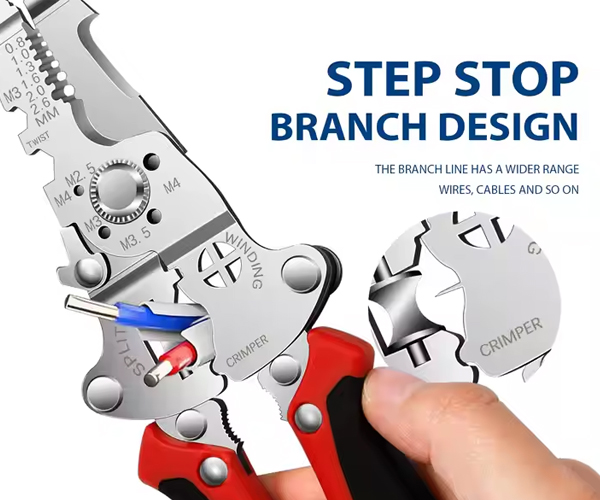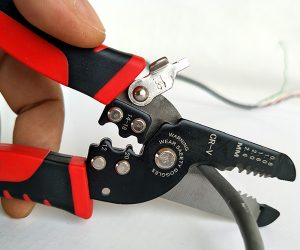When working with electrical projects, one essential tool that every professional or DIY enthusiast should have is a wire stripper. A wire stripper is a hand tool used to remove the insulation from electric wires without damaging the wire itself. In this article, we’ll explore the definition of a wire stripper, its uses, and why it’s important to have one in your toolkit. We’ll also dive into various types of wire strippers, how to use them effectively, and how to choose the right one for your needs. Ready to learn more? Let’s get started.
1. What is a Wire Stripper?
A wire stripper is a tool designed to remove the insulation from wires, typically used in electrical work. These tools are built to strip wires of various sizes and materials, such as copper or aluminum, without damaging the conductor inside. Wire strippers come in manual or automatic forms, with some offering adjustable settings to cater to different wire gauges. So, how exactly does a wire stripper work?
Wire strippers are equipped with cutting blades that grip the wire and cut through the insulation. The user places the wire into the tool, adjusts it for the desired wire gauge, and then squeezes the handles. The insulation is then cut away, exposing the wire underneath. The key feature of a wire stripper is that it can strip the wire cleanly without cutting into the wire itself, which is crucial for the integrity of the wire in any electrical system.
You might be wondering, how do you know which wire stripper is right for you? The answer depends on the wire size and material you’re working with. For example, some wire strippers are designed for heavier-duty applications, while others are made for finer, more delicate work.
2. Why Are Wire Strippers Important?
Wire strippers play a critical role in ensuring the safety and efficiency of any electrical installation. Without the right tool, stripping wire can be difficult and may result in damage to the wire, which could cause potential hazards. What’s the real story behind the importance of wire strippers?
First off, using a wire stripper prevents damage to the wire. If the insulation is removed incorrectly with a knife or another tool, it could cause the wire to break or expose too much of the conductor. This could lead to electrical shorts or even fires in severe cases. Wire strippers ensure a clean, safe strip that exposes the conductor without causing harm to the wire.
Furthermore, wire strippers improve the speed and efficiency of electrical work. The process of stripping wire by hand with a knife or similar tool is time-consuming and risky. A wire stripper speeds up the job, allowing professionals to finish projects faster, with fewer mistakes.
You’re probably thinking, do all wire strippers provide the same level of efficiency? Well, not all of them do. The quality and design of the tool can make a significant difference in how quickly and safely the job gets done.
3. How Do Wire Strippers Work?
So, how do wire strippers manage to strip insulation so effectively? Here’s where it gets interesting. Wire strippers rely on a combination of cutting blades and adjustable mechanisms to remove the insulation cleanly.
When you insert the wire into the stripper, the tool’s blades cut through the outer layer of insulation without touching the wire itself. The adjustable settings ensure that only the outer insulation is removed, and the underlying wire remains intact. These blades work in conjunction with a spring mechanism to apply the right amount of pressure.
You might be wondering, how do you ensure you’re using the wire stripper correctly? First, make sure you’ve set the tool to the correct gauge size of the wire you’re working with. Then, simply align the wire inside the tool, squeeze the handles, and pull the insulation off. It’s that simple.
Wire strippers can be used for various materials, including copper and aluminum, with some models having additional features, like a crimping function, for added convenience.

4. What Are the Different Types of Wire Strippers?
When it comes to wire strippers, there’s no one-size-fits-all solution. The right tool for the job depends on your specific needs. So, which type of wire stripper should you choose?
There are several types of wire strippers on the market, each designed to handle different wire gauges and materials. Manual wire strippers are the most common type, where the user applies pressure to the handles to cut and remove insulation. These tools are affordable and reliable for most general applications.
Automatic wire strippers, on the other hand, are designed to do the work for you. These tools automatically adjust to the wire gauge, making them ideal for professionals who need to strip multiple wires quickly. They are more expensive than manual models but can save time and effort.
Then, there are adjustable wire strippers, which allow the user to change the cutting width depending on the wire gauge. These are versatile tools that can be used for a variety of different projects.
Each type has its own pros and cons, so it’s essential to choose the one that best suits your work. So, now that you know the types, which one is right for you?
5. What Materials Can Be Stripped Using Wire Strippers?
Wire strippers are versatile tools that can handle various materials, but what exactly can they strip? This is where it gets even more interesting.
Copper and aluminum wires are the most common materials that wire strippers are designed to handle. These metals are widely used in electrical wiring due to their excellent conductivity. Stripping copper wire, for example, is straightforward with the right wire stripper, as long as the tool is properly adjusted.
But here’s the kicker: wire strippers can also be used for insulated wires. This means you can strip the insulation off multi-conductor cables without causing damage to the internal wires. In fact, using the right tool is crucial when working with insulated wires, as improper stripping can lead to shorts or other electrical issues.
When selecting a wire stripper, it’s important to check whether the tool is compatible with the materials you’re working with. Some wire strippers are made specifically for copper or aluminum, while others can handle a variety of different wire types.
6. How to Choose the Right Wire Stripper for Your Needs?
Choosing the right wire stripper can be tricky with so many options on the market. But here’s the good part: with a few simple considerations, you can pick the perfect tool for your needs.
First, you need to think about the wire gauge. Different wire strippers are designed to handle different wire gauges, so it’s essential to choose one that fits the type of wire you plan to work with. You don’t want a stripper that can’t handle the thickness of your wire, as this could lead to inaccurate stripping or tool damage.
Next, consider the type of wire stripper. Manual strippers are great for general use, but if you’re working on high-volume projects or need to strip many wires quickly, an automatic or adjustable stripper could be a better choice.
And don’t forget about comfort! Wire stripping can be hard on your hands, especially when you’re doing it for extended periods. Look for a stripper with ergonomic handles that provide a comfortable grip.
7. Can You Use Wire Strippers for Other Tasks?
While wire strippers are primarily designed to remove insulation, they can also be used for other tasks. This is where it gets useful.
Some wire strippers come with additional features like crimping functions. This allows users to strip and crimp the wire in a single tool, which is ideal for electrical work where connectors need to be attached to the stripped wire. It’s an excellent all-in-one tool for professionals who need to streamline their work.
Moreover, many wire strippers can also be used for cutting wire. While it’s not their primary purpose, some models have built-in cutting capabilities that make them even more versatile. It’s a great way to save time and effort if you’re doing both stripping and cutting in the same project.
Ready for the good part? Many wire strippers are designed for multi-purpose use, so whether you’re working on a household project or a more complex electrical installation, you can rely on one tool to handle multiple jobs.
8. What Are the Best Practices for Using Wire Strippers?
Using a wire stripper may seem straightforward, but there are some best practices you should follow to ensure safety and efficiency. First, let’s talk about how to get the perfect strip.
Start by selecting the correct gauge size on your wire stripper. If you use the wrong setting, you might strip too much of the insulation, or worse, damage the wire. Be sure to match the tool with the wire size you’re working on.
Next, make sure to handle the wire stripper properly. Hold it by the handles, not by the stripping area, and apply even pressure when squeezing the handles. Avoid forcing the tool, as this could cause damage to both the tool and the wire.
And here’s the real kicker: always wear protective gloves and goggles when stripping wire. While wire strippers are designed to be safe, it’s better to take precautions to avoid injury from flying debris or accidental slips.
9. What Are Common Issues with Wire Strippers?
Even the best tools can have their drawbacks, and wire strippers are no exception. So, what are the common problems you might face?
One issue is that the tool may not strip the wire cleanly if it’s not properly adjusted. If the blades are dull or the gauge setting is incorrect, you could end up with uneven strips or damaged wire. This can lead to poor connections and potential electrical issues.
Another common issue is tool wear and tear. Wire strippers are often exposed to harsh conditions, which can cause the blades to dull or break over time. Regular maintenance, such as cleaning and oiling the tool, can help extend its lifespan.
Finally, some wire strippers can be hard to use if you have large hands or poor grip strength. In these cases, you might need to look for an ergonomic model that fits your hand size better.
10. How Do You Maintain and Care for Wire Strippers?
Maintaining your wire stripper is crucial to ensure its longevity and efficiency. Here’s where the good part comes in: it’s not difficult at all to keep your wire stripper in great shape.
Start by cleaning the blades after each use. Wipe them down with a cloth to remove any debris or residue. If needed, use a mild soap and water solution to clean off any dirt that has accumulated.
Next, lubricate the moving parts regularly. A little oil on the hinges can prevent rust and ensure smooth operation. You might also want to check the tension of the spring mechanism to ensure it’s still working correctly.
And here’s the kicker: make sure to store your wire stripper properly. Keeping it in a dry, cool place will prevent rust and keep the tool in top condition.
11. Where Can You Buy Quality Wire Strippers?
If you’re looking to purchase a wire stripper, there are plenty of options available. So, where should you buy one?
You can find wire strippers at hardware stores, electrical supply stores, or online retailers. Some of the most popular brands are available at major retailers, such as Home Depot, Lowe’s, and Amazon. If you’re buying in bulk for a business, check out specialized wholesale suppliers.
But here’s the kicker: online marketplaces like Alibaba also offer a wide range of wire strippers, with many manufacturers offering OEM options for custom branding or bulk purchases. Be sure to check reviews and verify the reputation of the seller before buying.

12. How Much Do Wire Strippers Cost?
The cost of a wire stripper can vary depending on the type, brand, and features. You’re probably wondering, how much can you expect to pay?
Manual wire strippers usually range from $5 to $20, while automatic or adjustable models can cost anywhere from $20 to $50. High-end models with additional features like crimping or cutting capabilities may cost even more.
But here’s the kicker: while the cheaper models may work fine for general tasks, investing in a high-quality stripper can save you time and frustration in the long run. A well-built tool will last longer and provide better performance, making it worth the extra cost.
13. How Long Do Wire Strippers Last?
The lifespan of a wire stripper depends on its quality and how often you use it. High-quality models can last several years with proper care, but cheaper models might wear out quicker. What’s the real story behind their durability?
If you use your wire stripper daily for heavy-duty work, expect it to last around 1-3 years before showing signs of wear. For occasional use, a good wire stripper can last much longer. Regular maintenance can help extend its lifespan significantly.
Ready for the good part? By taking good care of your wire stripper, you can ensure it lasts for as long as possible, saving you money over time.
14. What Are the Most Popular Brands of Wire Strippers?
When it comes to buying wire strippers, brand reputation matters. Some brands have built a strong following due to their durability and performance. So, what are the most popular brands?
Some of the top brands in the market include Klein Tools, Ideal Industries, and Greenlee. These manufacturers are known for producing high-quality wire strippers that are trusted by electricians around the world. Many professionals swear by these brands due to their reliable performance and ergonomic designs.
But here’s the kicker: each brand offers a range of wire strippers for different applications. So, depending on your needs, you might want to explore models from multiple brands to find the one that works best for you.
15. How Can Wire Strippers Be Used in DIY Projects?
Wire strippers aren’t just for professionals; they can be incredibly useful in DIY projects as well. So, how can you use wire strippers for your next home improvement task?
Wire strippers are essential for any electrical work you do around the house. Whether you’re installing new lighting, repairing wiring, or building an electrical circuit, a wire stripper can help you remove insulation cleanly and safely. It’s the perfect tool for DIYers who want to work on their own electrical projects without hiring a professional.
And here’s the kicker: with the right wire stripper, you can handle even complex wiring tasks with ease. It’s a must-have tool for anyone looking to tackle electrical projects on their own.
FAQ Section
Q1: What is a wire stripper?
A wire stripper is a hand tool used to remove insulation from electrical wires without damaging the wire itself.
Q2: How does a wire stripper work?
Wire strippers work by using cutting blades to strip insulation from the wire while leaving the underlying conductor intact.
Q3: What materials can be stripped using wire strippers?
Wire strippers can handle copper, aluminum, and other conductive wires, both insulated and non-insulated.
Q4: How do I choose the right wire stripper for my project?
Choose a wire stripper based on wire gauge compatibility, the type of material you’re working with, and whether you need manual or automatic functionality.
Q5: How do I maintain my wire stripper?
To maintain your wire stripper, regularly clean it, lubricate the moving parts, and store it in a dry, cool place to prevent rust.
If you’re looking for high-quality, durable wire strippers, look no further! At Kolarwin Tools, we specialize in manufacturing top-notch hand tools, including wire strippers, designed to meet your needs. Whether you’re a wholesaler, distributor, or in need of OEM options, we can provide the right solutions for your business. Contact us today and let us help you get the best tools for your electrical projects!





